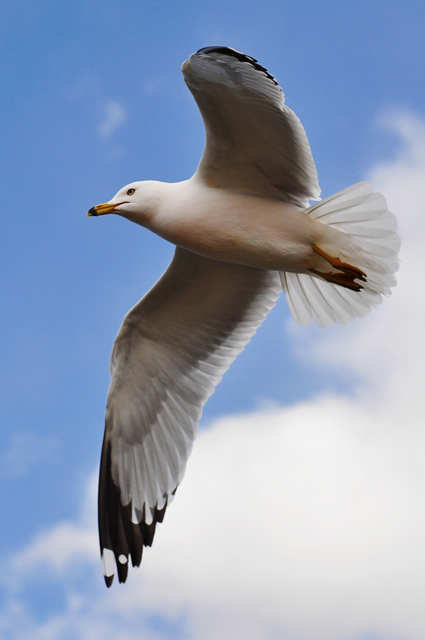
Pos-darwinista, the big Portuguese-language ID blog, draws our attention to this paper about the way gulls stabilize their flight and—just for fun—flags the design language in the Introduction:
Abstract: A gliding bird’s ability to stabilize its flight path is as critical as its ability to produce sufficient lift. In flight, birds often morph the shape of their wings, but the consequences of avian wing morphing on flight stability are not well understood. Here, we investigate how morphing the gull elbow joint in gliding flight affects their static pitch stability. First, we combined observations of freely gliding gulls and measurements from gull wing cadavers to identify the wing configurations used during gliding flight. These measurements revealed that, as wind speed and gusts increased, gulls flexed their elbows to adopt wing shapes characterized by increased spanwise camber. To determine the static pitch stability characteristics of these wing shapes, we prepared gull wings over the anatomical elbow range and measured the developed pitching moments in a wind tunnel. Wings prepared with extended elbow angles had low spanwise camber and high passive stability, meaning that mild perturbations could be negated without active control. Wings with flexed elbow angles had increased spanwise camber and reduced static pitch stability. Collectively, these results demonstrate that gliding gulls can transition across a broad range of static pitch stability characteristics using the motion of a single joint angle. (open access) – Wing morphing allows gulls to modulate static pitch stability during gliding C. Harvey , V. B. Baliga , P. Lavoie and D. L. Altshuler Published:02 January 2019https://doi.org/10.1098/rsif.2018.0641
1. Introduction
The Wright brothers were not the first to design an aircraft that produced sufficient lift to fly, but they were the first to successfully control and stabilize a powered aircraft [1]. Similarly, it is not enough for birds to simply produce sufficient lift and thrust; birds must also control and stabilize their flight paths to be able to successfully forage and migrate [2,3]. Flight stability can be maintained passively due to the morphology of a flyer, actively by adjusting control inputs or by a combination of both passive and active stability [2]. It has been proposed that birds have lost their passive stability through evolution in favour of unstable morphologies that require active control [3]. However, recent theoretical and anatomical work has suggested that, like most modern aircraft, birds use a combination of passive and active stability [2]. Yet, unlike modern aircraft, birds do not have discrete control surfaces such as ailerons and flaps. Instead, birds actively change the shape of their wings, known as wing morphing (figure 1a). To date, there are relatively few data on avian flight stability, and there is no empirical evidence demonstrating how wing morphing affects avian stability characteristics. Understanding if, and how, avian wing morphing stabilizes their flight provides both a broader understanding of how birds fly and inspiration for novel controls for unmanned aerial vehicles.
https://royalsocietypublishing.org/doi/full/10.1098/rsif.2018.0641
One wonders how the proper authorities
See also: Researchers: An Anti-Cancer Kill Code Is Embedded In Every Cell
Cell behavior can show “purposeful inefficiency”? What next?
and
Do cells use passwords?
Follow UD News at Twitter!